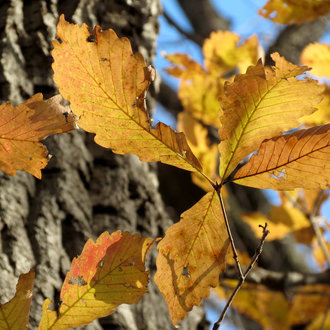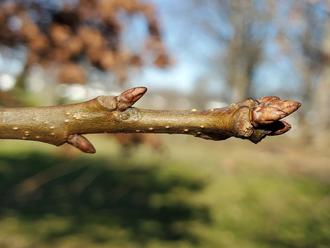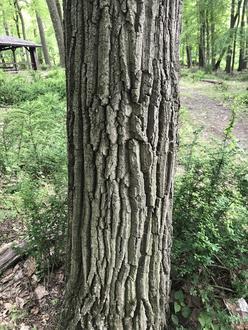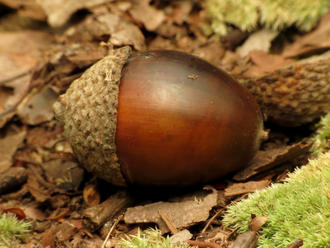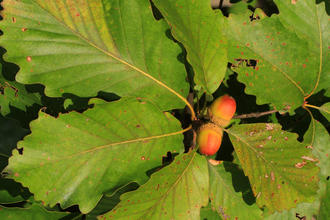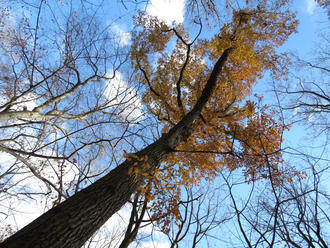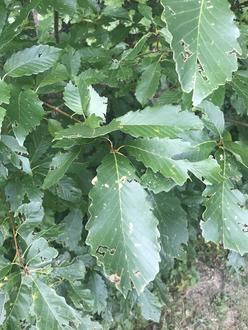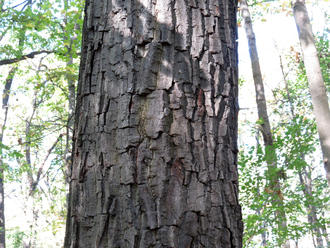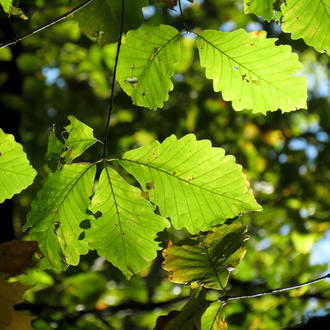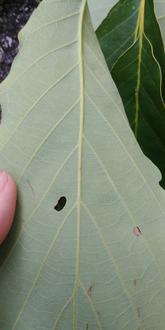Chestnut Oak (Quercus montana Willd.)
Also classified as Quercus prinus (see notes).
This species was formerly lumped in with swamp chestnut oak (Quercus michauxii), and the name Quercus prinus L. was associated with a type specimen belonging to that species, not this one. However some sources, including the USDA Silvics Manual, use the name Quercus prinus to refer only to this species and not to Q. michauxii. This can be confusing due to the fact that most modern authorities, including POWO, list Quercus prinus as a synonym of Q. michauxii and not of Q. montana.
↑Summary
A native oak of ridgetops and dry uplands with acidic soils, especially in the Appalachians, named for its resemblance to the American chestnut.
↑Description & Identification
A large tree, easily told apart from other similar-looking oaks by its distinctive bark and thin-capped acorns.
↑Similar Plants
↑Habitat
Found mostly in wooded slopes in upland areas, especially along ridges; also found in the Atlantic coastal plain from Virginia northward, on dry, sandy soils. Mostly found on rocky, dry soils common in mountains and upland areas. Often found on sites with acidic soil and low soil calcium and magnesium, especially those derived from sandstone, quartzite, and coarse-grained schist. Also found on coarse sands originating from marine or glacial deposits.
Typically found in later stages of succession on dry upland sites with poorer soils, especially ones that experience periodic low-intensity fires, including sites in pine barrens sheltered from the most severe fires. On these sites it often forms a climax community together with white and black oak. Found in intermediate successional stages on slightly richer sites, where it is often replaced by red maple in the absence of fire. On ridges where fire sometimes occurs it can persist indefinitely.
Found on sites with occasional low-to-moderate intensity ground fires, and infrequent severe fires, but absent from sites such as most pine barrens with more regular severe fires. This species tends to be more fire-resistant than scarlet, black, and white oaks, but is less resistant than pitch pine, blackjack oak, or post oak.
This species, along with other oaks, has tended to replace the once-dominant American chestnut (Castanea dentata) on uplands in the Appalachians, following its dieback due to the chestnut blight.
↑Life Cycle
Like most oaks, this species is slow growing and long-lived.
Trees begin producing seed around 20 years of age. Bumper crops are produced on average every 4-5 years, but are primarily determined by spring temperatures and do not necessarily occur at regular intervals. Seed production is highest when early April is warmer than average, followed by cooler than normal temperatures in early May. Seed crops are poor in years where temperature increases gradually and consistency from early spring to summer. On average, this species produces less seed than other upland oak species.
Acorns are not favored by squirrels for caching; although squirrels do play some role in distributing this species by caching acorns, they strongly prefer to eat the acorns immediately. Gravity also plays an important role in seed distribution, especially given this species' propensity to grow on ridgetops and steep slopes.
Acorns have a high germination rate (90%) and can germinate immediately after falling, but do so best in when temperatures range from 65°F(18°C) during day to 50°F(10°C) at night. Establishment is best in 1 inch of leaf litter, and seedlings establish poorly when litter is 2 inches or deeper. Acorns of this species have unique adaptations allowing them to absorb and retain water, enhancing germination and survival in dry soil. Due to the relatively large acorns with high stored energy, acorns are not very site-selective and estalish readily on a variety of sites, but long-term survival can be poorer on some sites.
After germination, seedlings establish a root system of about 5-6 inches in depth before sending up aboveground shoots in the subsequent growing season. Typically the aboveground stem will be about half the height of the root system. Aboveground growth is slow, as the plant invests more energy into root development. Trees growing in full sun may grow as much as 58 inches (under 5 feet) in 10 years, but as little as 6 inches under a forest canopy.
Seedlings cannot survive indefinitely under a closed canopy of more shade-tolerant trees such as red maple. However, seedlings can establish and grow to maturity under the more open canopies of less shade-tolerant species such as pitch pine, scarlet oak, or post oak.
Seedlings resprout vigorously, and repeatedly, if top-killed. Resprouts grow more rapidly than initial seedlings, owing in part to a more established root system. Chestnut oak is one of the most frequent and vigorous resprouters, more so than other upland oaks.
If a larger tree is cut, it will typically send up multiple shoots initially; over time, shoots progressively die back, leaving one two three primary shoots which can survive to regrow into a full-sized tree.
Mature trees are moderately resistant to fire, due to thick, insulating bark and a deep root system. They survive most ground fires without appreciable damage.
Trees commonly live to 300 years, some up to 400 years.
↑Uses
This tree is valued for its wood; it is typically lumped together with other oaks of the white oak group and sold generically as white oak. While it is one of the more valuable species to grow on dry upland sites, and it is common in the Appalachians, it is less likely to have good form, and as such is often seen as less attractive than Quercus alba.
Occasionally used in landscaping as a large shade tree, where it is valued for its longevity and tolerance of drought and infertile, rocky soils.
↑Related Plants
This oak is probably most closely related to white oak (Quercus alba) and swamp chestnut oak (Quercus michauxii). Following these, its most close relatives are mostly on other continents, but it is still relatively closely relatted to other white oaks native to North America.
↑Notes
This oak's common name references the resemblance of its bark to that of American chestnut trees, and to some degree, its leaves. It historically occupied the same habitat as chestnuts, prior to the blight that wiped out most of the chestnuts. It is the species that has expanded most to occupy the niche left vacant by chestnuts following the blight.
Early literature referred to both this species and Q. michauxii as varieties of a single species, Quercus prinus. They are now treated as separate species.
↑Links & External Resources
• Quercus montana (Chestnut Oak) | USDA PLANTS Database (About This Site)
• Quercus montana | Go Botany (About This Site)
• Chestnut Oak | iNaturalist (About This Site)
• Quercus montana (Chestnut Oak) | Missouri Botanical Garden Plant Finder (About This Site)
• Chestnut Oak | Virginia Tech Dendrology Factsheets (About This Site)
• Quercus michauxii, Q. montana | Fire Effects Information System (FEIS) (About This Site)
• Chestnut Oak | The Wood Database (About This Site)
• Quercus montana | Biota of North America Project (BONAP) (About This Site)
• Quercus montana | Flora of North America (About This Site)
• Chestnut Oak (Quercus prinus L.) | Silvics of North America (About This Site)
• Chestnut Oak | Maryland Biodiversity Project (About This Site)
• Quercus montana Willd. | Plants of the World Online (POWO) (About This Site)
• Quercus montana Willd. (Chestnut Oak, Rock Chestnut Oak) | Digital Atlas of the Virginia Flora (About This Site)



